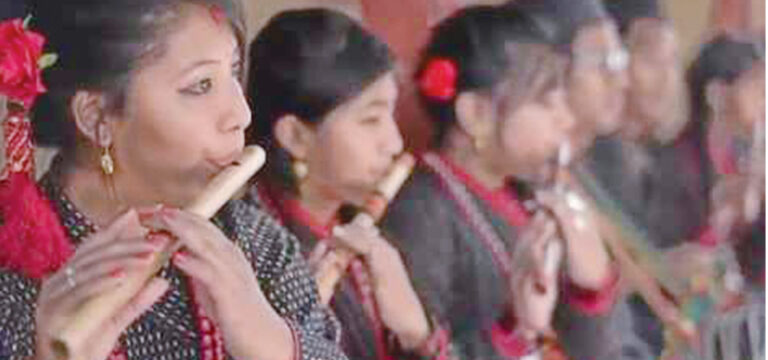
Manoj Bhattarai
With the arrival of Dashain, television, radios and telecom service providers have started playing the Malashree tune to put people in a festive mood. The auspicious tune is believed to evoke Goddess Durga and is played from the beginning of the Nepali month of Ashwin to welcome Dashain into our homes and communities.
History of Malashree tune
Malashree tune is related to the autumn season. In Nepal, seasons have always been interpreted in musical form and all six seasons and 12 months have a special tune associated with them. But Malashree holds a special significance because it is linked with the biggest festival of the country.
Malashree tune is played twice a day – in the morning and evening – and before worshipping gods and goddesses. The tune is believed to have originated in the 16th century during the reign of King Mahendra Malla. During the Malla era, the tune used to be played in all the towns and villages of Kathmandu Valley and surrounding areas during the 15 days of Dashain.
After the unification of Nepal by King Prithvi Narayan Shah, the tune spread to other parts of the kingdom and acquired national prominence.
Malashree tune can be played with any musical instrument. Usually, the Naumati Baja, nine traditional musical instruments, or Panche Baja, five folk instruments, are played but the tune can also be created by modern musical instruments like guitar, violin and harmonium.
The tune is dedicated to Saptamatrika – the seven mother goddesses.
What is Malashree tune
The Malashree tune is also called the Dashain tune because of its association with the festival. According to Pandit Pandav Khatiwoda of Jaleshwor Vidyapeeth, Okhaldhunga, Malashree is a classical tune played to attract good fortune.
Khatiwoda said that there is a written history about the tune dating
back to the Lichhavi period. He also informed that the name Malashree was derived with the combination of two words Mala and Shree with the former meaning material possessions and the latter meaning the blessings of Goddess Laxmi.
In addition to marking Dashain, this tune also celebrates the upcoming harvest season. “Nepal, being an agricultural country, places huge importance on nature and seasons. This tune is a reflection of that,” Khatiwoda said.
Tune disappearing
Despite the sweet melody and the association of the tune with Dashain, Malashree tune is falling out of favour with youths.
Nanda Prasad Bhattarai, 95, of Likhu Rural Municipality–6, remembers a time when nearly every house in his village played the tune from Ghatasthapana to Kojagrat Purnima. “This music was what made Dashain like Dashain,” he said, adding, “However, these days, the tune is only limited to radio and television.”
“A lack of people able to play the folk musical instruments and declining interest among the youths has negatively impacted the musical culture,” said Dan Bahadur Baniya, chairman of Ward No. 9 of Siddhicharan Municipality. “The young people of today prefer to listen to western music rather than their own traditional tunes. This is why the Malashree tune is receding.”
“Up until the generation of our fathers and grandfathers, everyone used to gather at the houses of village leaders and play the Malashree tune. However, once that generation dies, we fear that the music will die too,” worried Gyanendra Kumar Maskey, president of the Okhaldhunga Chamber of Commerce and Industry.
Maskey called on the local government to preserve this tune and the culture associated with it.
Source : TRN,






